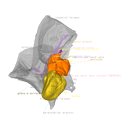

















| Plane | Position | Flip |
| Show planes | Show edges |
0.0
M3#4
Labelled exploded model of the right ear region of Hippopotamus amphibius (UM N 179)
Data citation:
Maëva J. Orliac , Franck Guy
and Renaud Lebrun
, 2015. M3#4. doi: 10.18563/m3.sf4
Tag legend:
bulla, parietal, petrosal, sinus
Model solid/transparent
Flags:
auditory meatus, basicapsular groove, caudal tympanic process, contact with auditory tube, eustachian tube, external auditory meatus, fenestra cochleae, fenestra vestibuli, foramen for temporal branches, geniculum of canalis fascialis, glazerian fissure, glenoid surface, Hiatus fallopii, internal acoustic meatus, mastoid region, paracondylar process, posterior crus of tympanic anulus, postympanic process, prefacial commissure fossa, promontorium, round oval fossa for tensor tympani, Sigmoid sinus, sigmoid sinus, subarcuate fossa, sulcus tympanicus, suprameatal foramen, suprameatal foramen, Tegmen tympani, temporal branch, temporal branch, temporal branch, temporal sinus, temporal sinus, transverse sinus, tributary branches of capsulo parietal emissary vein system, tympanic neck, tympanohyal sulcus, ventrolateral process

|
Osteological connexions of the petrosal bone of the extant Hippopotamidae Hippopotamus amphibius and Choeropsis liberiensisMaëva J. Orliac, Franck Guy and Renaud LebrunPublished online: 24/10/2014Keywords: Artiodactyla; bulla; ear region; pygmy hippo; sinus https://doi.org/10.18563/m3.1.1.e1 Abstract This project presents the osteological connexions of the petrosal bone of the extant Hippopotamidae Hippopotamus amphibius and Choeropsis liberiensis by a virtual osteological dissection of the ear region. The petrosal, the bulla, the sinuses and the major morphological features surrounding the petrosal bone are labelled, both in situ and in an exploded model presenting disassembly views. The directional underwater hearing mode of Hippopotamidae is discussed based on the new observations. M3 article infos Published in Vol. 01, Issue 01 (2015) |
|